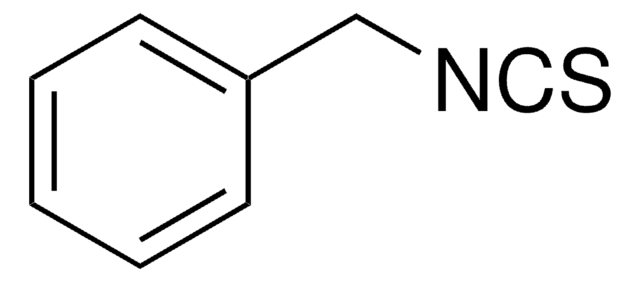Key Documents
SML3434
Erucin
≥98% (HPLC)
Synonim(y):
(4-Isothiocyanatobutyl)(methyl)sulfane; 4-(Methylthio)butyl isothiocyanate, 1-Isothiocyanato-4-(methylthio)butane, ERU, MTBITC
About This Item
Polecane produkty
Poziom jakości
Próba
≥98% (HPLC)
Postać
oil
kolor
colorless to yellow
temp. przechowywania
-10 to -25°C
ciąg SMILES
CSCCCCN=C=S
InChI
1S/C6H11NS2/c1-9-5-3-2-4-7-6-8/h2-5H2,1H3
Klucz InChI
IHQDGXUYTSZGOG-UHFFFAOYSA-N
Działania biochem./fizjol.
Hasło ostrzegawcze
Danger
Zwroty wskazujące rodzaj zagrożenia
Zwroty wskazujące środki ostrożności
Klasyfikacja zagrożeń
Eye Dam. 1 - Skin Corr. 1B
Kod klasy składowania
8A - Combustible corrosive hazardous materials
Klasa zagrożenia wodnego (WGK)
WGK 3
Temperatura zapłonu (°F)
Not applicable
Temperatura zapłonu (°C)
Not applicable
Certyfikaty analizy (CoA)
Poszukaj Certyfikaty analizy (CoA), wpisując numer partii/serii produktów. Numery serii i partii można znaleźć na etykiecie produktu po słowach „seria” lub „partia”.
Masz już ten produkt?
Dokumenty związane z niedawno zakupionymi produktami zostały zamieszczone w Bibliotece dokumentów.
Nasz zespół naukowców ma doświadczenie we wszystkich obszarach badań, w tym w naukach przyrodniczych, materiałoznawstwie, syntezie chemicznej, chromatografii, analityce i wielu innych dziedzinach.
Skontaktuj się z zespołem ds. pomocy technicznej








